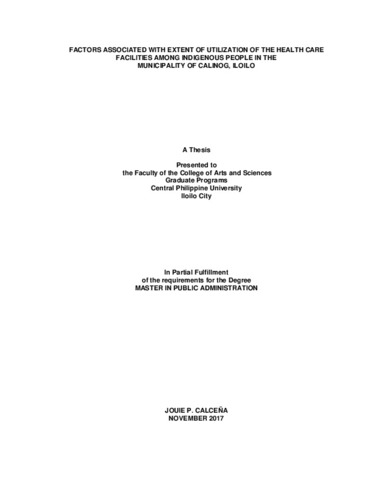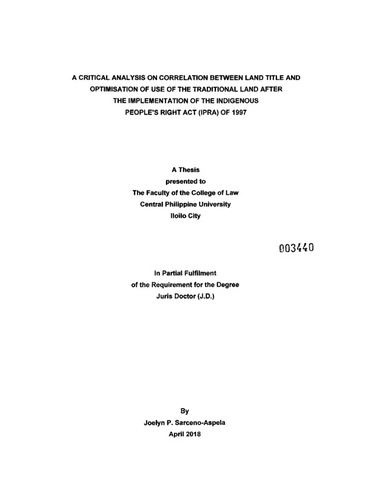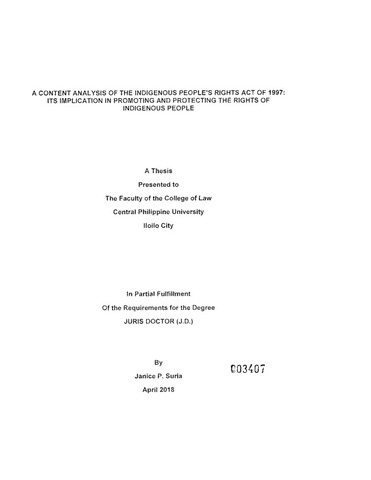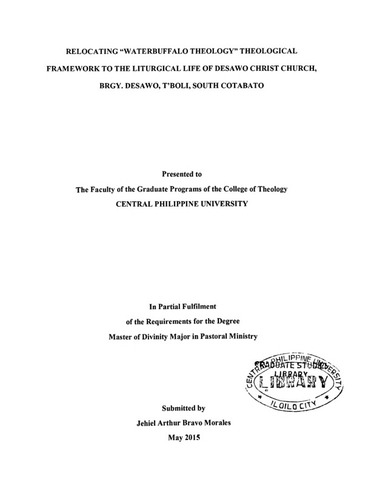Factors associated with extent of utilization of the health care services among indigenous people in the Municipality of Calinog, Iloilo

Page views
1,544Petsa
2017May-akda
Tagapayo ng Tesis
Tagapangulo ng Panel ng Depensa
Magbahagi
Metadata
Ipakita ang buong tala ng item
Abstract
This quantitative-descriptive correlational research sought to examine the factors associated with the extent of utilization of health care services of Panay-Bukidnon Indigenous Peoples in the Municipality of Calinog, Province of Iloilo. Specifically, this study aimed to: describe the selected characteristics of the respondents in terms of age, sex, educational attainment, occupational status, and income; determine the respondents’ level of awareness of health services, the accessibility to health services, and their’ extent of utilization of health services, on the BHS; determine if there is a significant relationship between selected characteristics of respondents and their level of awareness of health services, their accessibility to health services, and their extent of utilization of health services; determine if there is a significant between their level of awareness and extent of utilization of health services.
The sample respondents of this study were utilization 171 Panay-Bukidnon Indigenous People Barangays Binolusan Grande, Caratagan and Manaripay, in the Municipality of Calinog, Province of Iloilo. The sample respondents were drawn in using Stratified Random Sampling. The Statistical Package for Sciences Software (SPSS) was used and analysis of data.
This study found out that there were more females than males and more married than single respondents and the IPs.
Majority of the IP respondents had a high level of awareness about health services but due to distance between house and travelling time, they failed to attend or participate in seminars and information dissemination about health.
In addition, the study found out that age is a significant determinant of extent of utilization of health services. The data also showed that the younger the respondents, the higher their extent of utilizing health care services offered in the barangay health station. Also, respondents who were employed as well as those who had a higher household. Furthermore, it follows that respondents who have a high level of awareness also have a high extent of utilization.
Paglalarawan
Abstract only
Mungkahing Sipi
Calceña, J. P. (2017). Factors associated with extent of utilization of the health care services among indigenous people in the Municipality of Calinog, Iloilo (Unpublished Master’s thesis). Central Philippine University, Jaro, Iloilo City.
Uri
ThesisMga Paksa
Mga keyword
Kagawaran
School of Graduate StudiesDegree
Master in Public AdministrationLokasyon ng Istante
GSL Theses 351.072 C126
Pisikal na paglalarawan
75 leaves
Collections
Mga parehong item
Ipinapakita ang mga item na nauugnay sa pamagat, may-akda, tagalikha at paksa.
-
A critical analysis on correlation between land title and optimisation of use of the traditional land after the implementation of the Indigenous People’s Right Act (IPRA) of 1997
Sarceno-Aspela, Joelyn P. (2018)The fundamental development of indigenous people lies in the recognition of their rights to their traditional territories. This study was conducted to examine the experiences of indigenous communities after the recognition ... -
A content analysis of the Indigenous People’s Rights Act of 1997: Its implication in promoting and protecting the rights of indigenous people
Suria, Janice P. (2018)This study was primarily conducted to analyze the content of The Indigenous People’s Right Act of 1997 (IPRA) to determine its implication in promoting and protecting the rights of indigenous people. It was conducted within ... -
Relocating "Waterbuffalo Theology" theological framework to the liturgical life of Desawo Christ Church, Brgy. Desawo, T'Boli, South Cotabato
Morales, Jehiel Arthur B. (2015)This study sought to relocate “Waterbuffalo Theology” to the worship life of the T’boli in Desawo Christ Church. Particularly, it sought to critically analyze on how Christianity have changed the T’boli people in their ...






